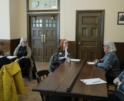
Recognizing a Stroke

Strokes are sudden, silent and deadly. Here’s how to know if you’re having one – and what to do about it.
By Wendy Roberts
Valerie Greene, author of Conquering Stroke, was 31 and the picture of health when she suffered a massive stroke – the No. 3 killer of women, killing twice as many women as breast cancer. “I just thought I had a really bad headache. I went home early and got into the shower,” she tells PINK. “I completely lost my balance and fell to the floor.” Greene called 911, and doctors later told her it had been a migraine.
Over the next six months, Greene would continue to experience symptoms of stroke but was continually misdiagnosed until, finally, she had what she describes as “an earthquake of the body,” an ischemic stroke. A large blood clot had formed in the stem of her brain, blocking blood flow and causing that part to start dying. Greene, who has made a miraculous 90 percent recovery since then, attributes the severity of her stroke to ignoring her symptoms and misdiagnosis.
“I kept thinking they would go away, that I was stressed out and just needed to be stronger,” Greene says. “I think as women we tend to do that a lot. Women need to start taking care of themselves and listening to their bodies. Stroke can happen to any of us at any time; age does not matter.”
The Warning Signs
The American Academy of Neurology (along with actress Morgan Fairchild), the American College of Emergency Physicians and the American Stroke Association have teamed up to create the “Give Me 5” for Stroke campaign to help educate the public on how to recognize stroke symptoms.
The five symptoms are:
1. Walk: Is your balance off?
2. Talk: Is your speech slurred or face droopy?
3. Reach: Is one side weak or numb?
4. See: Is your vision completely or partially lost?
5. Feel: Is your headache severe?
If you or anyone you know experiences any of these symptoms, call 911 immediately and tell them you are having a stroke. This alerts the EMTs to transport you to a hospital with a stroke center and the lifesaving “clot busters,” or TPAs, you will need to dissolve the clot.
What to Do
Karen Furie, M.D., stroke expert and member of the American Academy of Neurology, offers these tips to help people receive the best treatment possible.
1. Do not wait! Too often people wait, thinking the symptoms will eventually go away. “This is the worst thing you can do,” she says. “Immediately call 911 and tell them you are having a stroke. There is only a three-hour window in which the clot busters can be administered.”
2. Do not drive yourself to the hospital – or have someone take you there. The EMTs will be able to get you to a stroke center faster, and you’ll have a better chance of receiving a more accurate diagnosis.
3. Do your part to help lower your risk. Since women outlive men in general, we need to take additional steps to stay healthy. Dr. Furie recommends keeping your blood pressure down and your cholesterol levels under control. Don’t smoke, and keep heavy alcohol consumption to a minimum or eliminate it completely. Plus, eating a balanced diet of fruits and vegetables that is low in fat and salt, along with doing regular exercise, can lower your risk significantly.
Recommended
-
5 Skin Care Trends: What Profe...April 10th, 2024
-
Is It Time To Change Your Rela...March 20th, 2024
-
Resilience & Transformati...February 20th, 2024
-
Medical Malpractice Lawsuits: ...October 31st, 2023
-
Be Here Now—Two Easy StepsSeptember 19th, 2023















